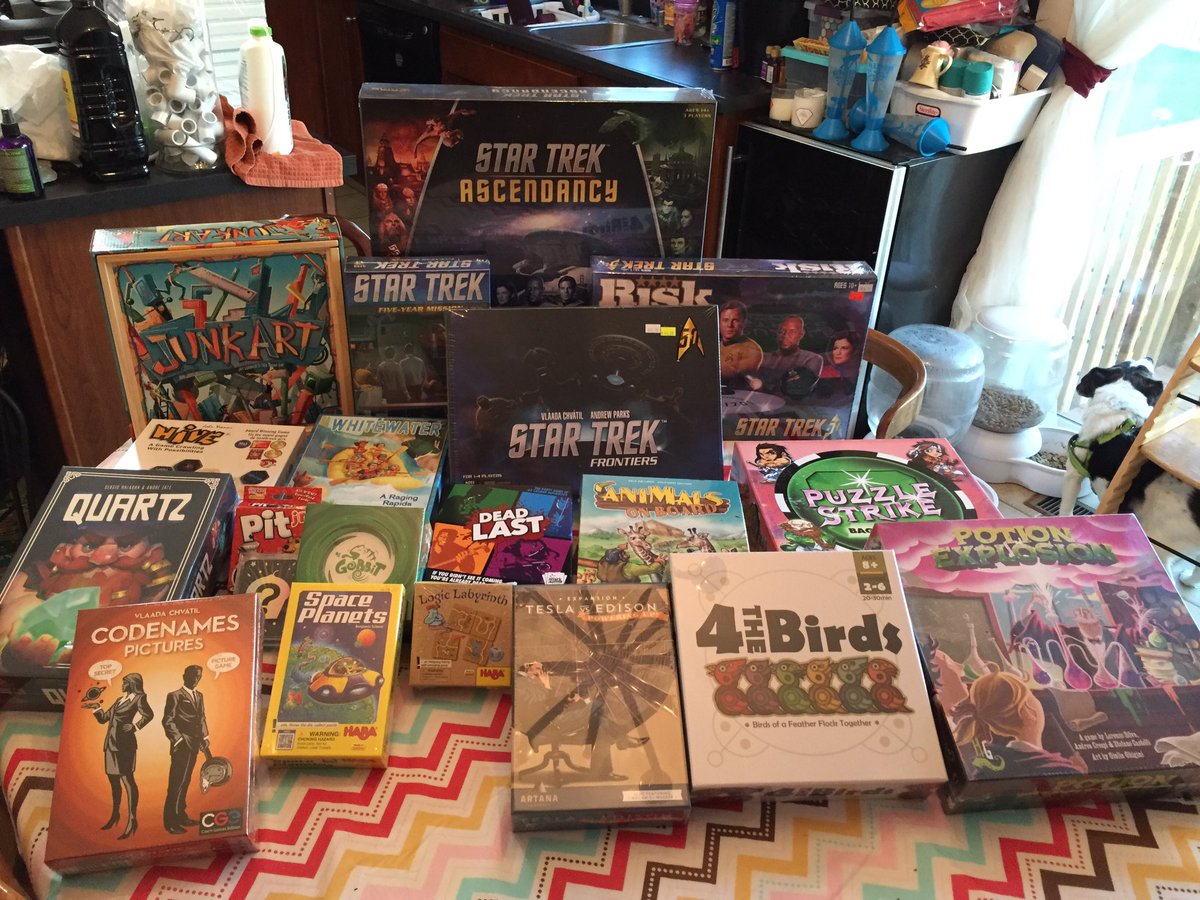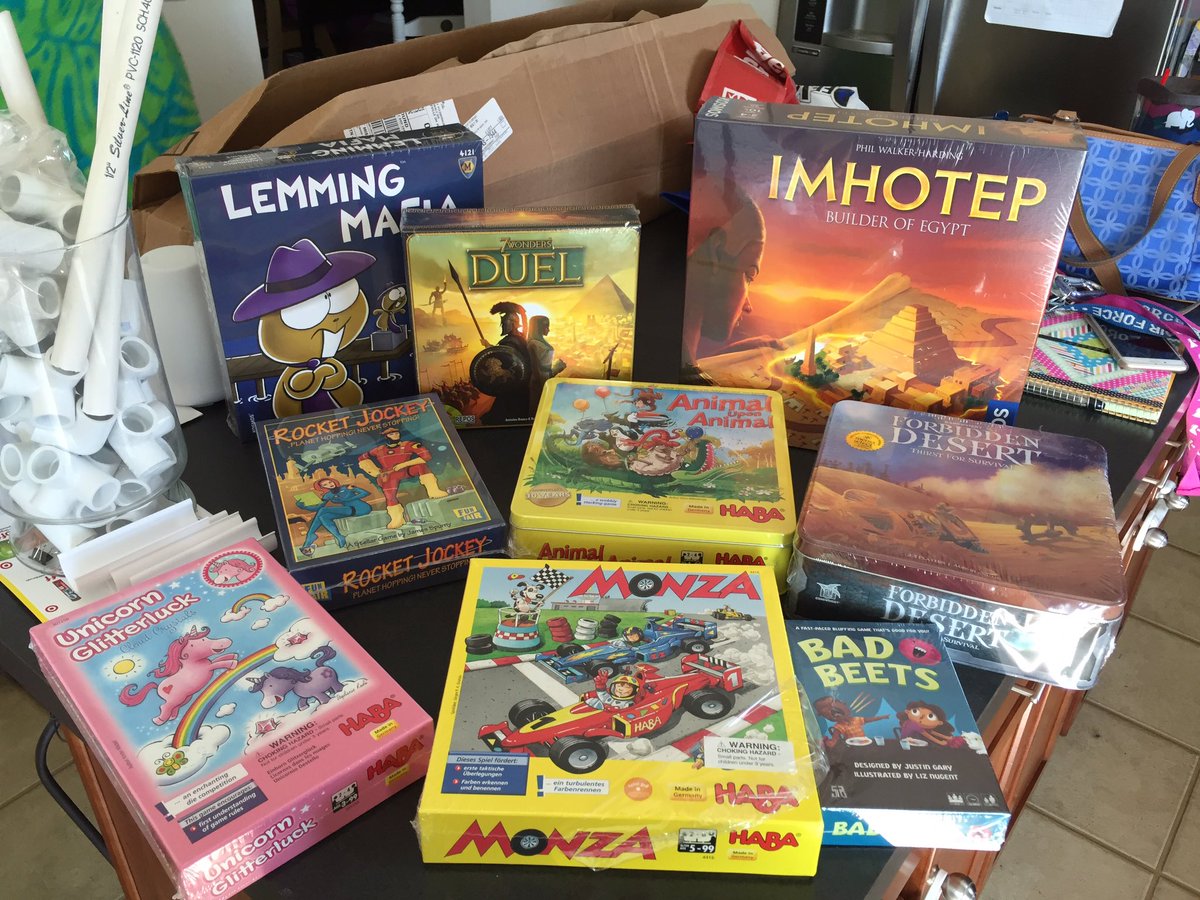I attend both of these shows for business purposes, as I represent some of the companies for trademark and contract-type work. I also give presentations for new and indie game designers on IP law with one of my co-workers who also may be found at the local board game bar from time to time. Not to mention the tons of networking with podcasters and other folks. That being said, obviously we have some fun attending these shows because that's what it's all about!
However, GenCon marks the major release for most board game products in the U.S., and I become a consumer at that show most years as well. Let's take a look at this year's haul, which is much larger than normal:

That's 20 games or expansions total. Wow! Even comparing that to Origins (picture below, only missing Karuba which I had shipped to me post-show), it's a lot:

To say we have some "new shinies" and "SEALWRAP!" to enjoy in the Fitzgerald household and with our gaming groups is an understatement. However, it's been fun diving into all of these new (or new to us) titles.
Many of these games are intended for play with the three daughters, but our oldest is turning 8 this week and she is honestly able to pick up and play even many of the games we bought intending for adults to play. That being said, the various HABA games you see have been a big hit, particularly simple stuff like Unicorn Glitterluck for the two younger daughters (5.5 and 2.5), who are way into princesses and pink and unicorns and My Little Pony and on and on.
For lighter gamers, we have had an absolute blast with all of the Spiel award nominees for 2016 (most prestigious game of the year award in the industry): Imhotep, Karuba, and Codenames. The new Codenames Pictures adds a very interesting element to the game when comparing it to the normal version with words, but both are fun. Hell, with that innovative design, you could play with Cards Against Humanity cards and still have a good time. There is a black box adult version of Codenames available now from Czech Games as well, FWIW.
I've more than doubled my Star Trek theme game collection thanks to the GenCon acquisitions, with many new titles being released on or around the 50th anniversary in 2016. The best of these for capturing the essence of Star Trek is definitely Ascendancy, but I should save my detailed thoughts on that for a future entry. It's been an absolute blast playing Star Trek Risk and other co-op games with Paige, our oldest. She is just as much into Star Trek as I am, and risk is a game you just have to pass down from generation to generation, even though it's not the best game design. For more of my thoughts on Star Trek games, check out my Character Insight segments from August which played on the This Week in Trek podcast:
- http://characterinsight.blogspot.com/2016/08/character-insight-no-203-trek-tabletop.html
- http://characterinsight.blogspot.com/2016/08/character-insight-no-202-trek-tabletop.html
HOUSE RULES
The other topic I want to briefly discuss today is the importance of using House Rules. Certainly game designers try their best to make games as good as possible, but there are times when the rules just are not ideal, or not ideal for certain player counts. I've run into this issue a few times while playing the new games from the summer conventions.
For example, simplifying games for use with kids can make for a game that hits the table far more frequently than it would otherwise. The missing rules can be added back in as the children grow more comfortable with the game and more adept as gamers.
Star Trek Risk has a basic rule set without the event cards and quests and crew member abilities which basically turns it into generic Risk. The difference between that and the full game with all of those features was a jump too high for Paige. Thus, I have experimented with adding one or two of these advanced rules at a time, and the result has been a fun and varied experience. We are getting different experiences from a single game, AKA more bang for the buck as we go. Legacy Games aren't the only games that can provide this!
Another game in this line is Potion Explosion, which has a very simple but fun tactile mechanic of pulling marbles from a box containing multiple rows of marbles to complete recipes for potions. Depending on the type of potion, they all give a special one-time use effect after you complete them. By simply removing this rule as an introductory version via House Rules for kids or teaching the game, the game is playable by even our middle child. It's still very fun as well! I encourage those with kids to experiment with House Rules or removing rules to bring complexity levels down so you can play some of your favorite tabletop games for many more years as your kids grow up and hopefully become game enthusiasts themselves. I can't think of many better ways to spend quality time with the littles.
The final example I will give for today is Quartz (I have House Rules for Star Trek Ascendancy working as well but again, that's a discussion for its own post), which is identified as a press-your-luck type of game with "take that" player interactions with cards you can play against your other players. The basic game play is pulling gem stones out of a bag, which is again a fun tactile experience, and hoping to collect valuable colors of gems rather than black gems called Obsidian. In the rules as written in the rule book, you play 5 rounds of this and you "bust out" and get no points if you ever pull or get given (via the cards) a second Obsidian.
In my view, this leads to games which tend to be a bit too long for the type of experience being offered, and it also leads to player elimination feeling really bad when your first two gems are Obsidian and then you get to watch everyone else play, sometimes for a long time before you get back in during the next round. The game tries to temper this problem by giving you a token when you bust out for one-time use on a future day where you can remove an Obsidian instantly, such as when you would get a second, to save you that round. That does not seem like enough to solve this problem.
Thus, I developed House Rules for Quartz where you play 4 rounds instead of 5, and you bust out only when you get a third Obsidian. At least for 2 and 3 player games (2 player is not anticipated by the game but we've found it to work with another optional rule allowing the last player in the mine for the day to mine up to 4 more crystals), this has been brilliant because it actually captures the feel of other press-your-luck type games while slightly diminishing the mean aspects of the game where the "take that" cards can repeatedly bust someone out quickly in consecutive rounds. While this may not work as well for 4 and 5 players due to a limited number of Obsidian being in the gem bag (I'd still recommend 4 rounds as that's enough to have a full game experience), the change has totally revamped Quartz into a game that will see the table a lot in our family.
UPDATE: Have played with 4 with these house rules, and the only change I would recommend is to remove the tokens you get for busting out. Those tend to be too powerful and make rounds go too long when you are not busting out at 2 Obsidian. This may also be correct in the 2 or 3 player version of the house rule game as well.
Put simply, don't be afraid to experiment with House Rules. Sure, you have to sometimes be creative like a game designer, but it can make your game collection far more versatile and enjoyable. Until next time, happy gaming.
